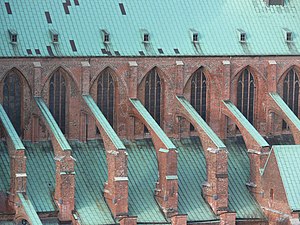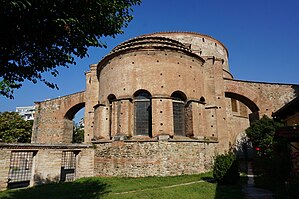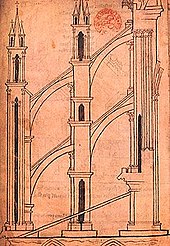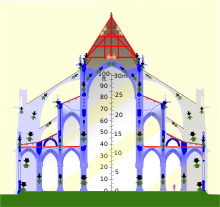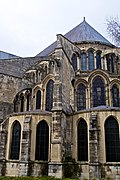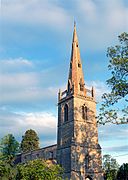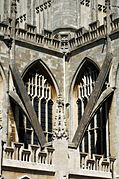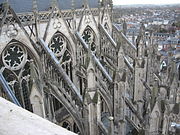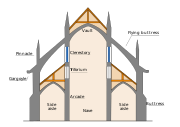
Romanesque architecture is an architectural style of medieval Europe that was predominant in the 11th and 12th centuries. The style eventually developed into the Gothic style with the shape of the arches providing a simple distinction: the Romanesque is characterized by semicircular arches, while the Gothic is marked by the pointed arches. The Romanesque emerged nearly simultaneously in multiple countries ; its examples can be found across the continent, making it the first pan-European architectural style since Imperial Roman architecture. Similarly to Gothic, the name of the style was transferred onto the contemporary Romanesque art.

Gothic architecture is an architectural style that was prevalent in Europe from the late 12th to the 16th century, during the High and Late Middle Ages, surviving into the 17th and 18th centuries in some areas. It evolved from Romanesque architecture and was succeeded by Renaissance architecture. It originated in the Île-de-France and Picardy regions of northern France. The style at the time was sometimes known as opus Francigenum ; the term Gothic was first applied contemptuously during the later Renaissance, by those ambitious to revive the architecture of classical antiquity.
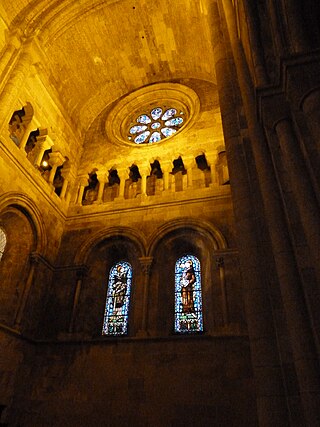
A triforium is an interior gallery, opening onto the tall central space of a building at an upper level. In a church, it opens onto the nave from above the side aisles; it may occur at the level of the clerestory windows, or it may be located as a separate level below the clerestory. Masonry triforia are generally vaulted and separated from the central space by arcades. Early triforia were often wide and spacious, but later ones tend to be shallow, within the thickness of an inner wall, and may be blind arcades not wide enough to walk along. The outer wall of the triforium may itself have windows, or it may be solid stone. A narrow triforium may also be called a "blind-storey", and looks like a row of window frames.

A pinnacle is an architectural element originally forming the cap or crown of a buttress or small turret, but afterwards used on parapets at the corners of towers and in many other situations. The pinnacle looks like a small spire. It was mainly used in Gothic architecture.

In architecture, a clerestory is a high section of wall that contains windows above eye-level. Its purpose is to admit light, fresh air, or both.

A rib vault or ribbed vault is an architectural feature for covering a wide space, such as a church nave, composed of a framework of crossed or diagonal arched ribs. Variations were used in Roman architecture, Byzantine architecture, Islamic architecture, Romanesque architecture, and especially Gothic architecture. Thin stone panels fill the space between the ribs. This greatly reduced the weight and thus the outward thrust of the vault. The ribs transmit the load downward and outward to specific points, usually rows of columns or piers. This feature allowed architects of Gothic cathedrals to make higher and thinner walls and much larger windows.

A barrel vault, also known as a tunnel vault, wagon vault or wagonhead vault, is an architectural element formed by the extrusion of a single curve along a given distance. The curves are typically circular in shape, lending a semi-cylindrical appearance to the total design. The barrel vault is the simplest form of a vault: effectively a series of arches placed side by side. It is a form of barrel roof.

The Cathedral Church of St. James is an Anglican cathedral in Downtown Toronto, Ontario, Canada. It is the location of the oldest congregation in the city, with the parish being established in 1797. The church, with construction beginning in 1850 and opening for services on June 19, 1853, was one of the largest buildings in the city at that time. It was designed by Frederick William Cumberland and is a prime example of Gothic Revival architecture.

The Cathedral Basilica of Our Lady of Amiens, or simply Amiens Cathedral, is a Roman Catholic church. The cathedral is the seat of the Bishop of Amiens. It is situated on a slight ridge overlooking the River Somme in Amiens, the administrative capital of the Picardy region of France, some 120 kilometres north of Paris.
In French Gothic architecture, the Rayonnant style is the third of the four phases of Gothic architecture in France, as defined by French scholars. Related to the English division of Continental Gothic into three phases, it is the second and larger part of High Gothic.

A groin vault or groined vault is produced by the intersection at right angles of two barrel vaults. The word "groin" refers to the edge between the intersecting vaults. Sometimes the arches of groin vaults are pointed instead of round. In comparison with a barrel vault, a groin vault provides good economies of material and labor. The thrust is concentrated along the groins or arrises, so the vault need only be abutted at its four corners.
This page is a glossary of architecture.

French architecture consists of numerous architectural styles that either originated in France or elsewhere and were developed within the territories of France.

English Gothic is an architectural style that flourished from the late 12th until the mid-17th century. The style was most prominently used in the construction of cathedrals and churches. Gothic architecture's defining features are pointed arches, rib vaults, buttresses, and extensive use of stained glass. Combined, these features allowed the creation of buildings of unprecedented height and grandeur, filled with light from large stained glass windows. Important examples include Westminster Abbey, Canterbury Cathedral and Salisbury Cathedral. The Gothic style endured in England much longer than in Continental Europe.

French Gothic architecture is an architectural style which emerged in France in 1140, and was dominant until the mid-16th century. The most notable examples are the great Gothic cathedrals of France, including Notre-Dame Cathedral, Reims Cathedral, Chartres Cathedral, and Amiens Cathedral. Its main characteristics are verticality, or height, and the innovative use of the rib vault and flying buttresses and other architectural innovations to distribute the weight of the stone structures to supports on the outside, allowing unprecedented height and volume. The new techniques also permitted the addition of larger windows, including enormous stained glass windows, which fill the cathedrals with light.
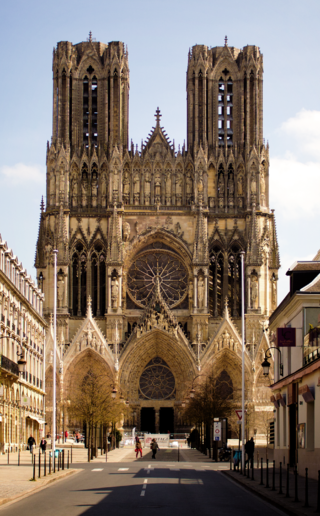
High Gothic followed Early Gothic architecture and was succeeded in France by Late Gothic in the form of the Flamboyant style. This timetable is not used by French scholars; they divide Gothic architecture into four phases, Primary Gothic, Classic Gothic, Rayonnant Gothic and Flamboyant Gothic. Therefore, in French terms, a few first examples of High Gothic are Classic, but most examples are Rayonnant. High Gothic is often described as the high point of the Gothic style.

Early Gothic is a term for the first phase of Gothic style, followed by High Gothic and Late Gothic, dividing the whole Gothic era into three periods. It is defined as a style that used some principle elements of Gothic, but not all. Especially, it had no fine tracery. It marks the first phase of a division of Gothic Style into three periods. If it is used for all countries, it has to be regarded that there may be special terms for the styles of single countries, such as Early English in England.

Perpendicular Gothic architecture was the third and final style of English Gothic architecture developed in the Kingdom of England during the Late Middle Ages, typified by large windows, four-centred arches, straight vertical and horizontal lines in the tracery, and regular arch-topped rectangular panelling. Perpendicular was the prevailing style of Late Gothic architecture in England from the 14th century to the 17th century. Perpendicular was unique to the country: no equivalent arose in Continental Europe or elsewhere in the British Isles. Of all the Gothic architectural styles, Perpendicular was the first to experience a second wave of popularity from the 18th century on in Gothic Revival architecture.

Classic Gothic is a French term for the second phase of Gothic architecture in France, as defined by French scholars. The common English term for the period is High Gothic. This is disputed by German scholars. The German definition of High Gothic requires bar tracery, which did not arrive in French cathedrals until the construction of Reims Cathedral, but the English definition does not.
